charging MITSUBISHI OUTLANDER PHEV 2014 Owner's Manual (in English)
[x] Cancel search | Manufacturer: MITSUBISHI, Model Year: 2014, Model line: OUTLANDER PHEV, Model: MITSUBISHI OUTLANDER PHEV 2014Pages: 442, PDF Size: 19.04 MB
Page 3 of 442
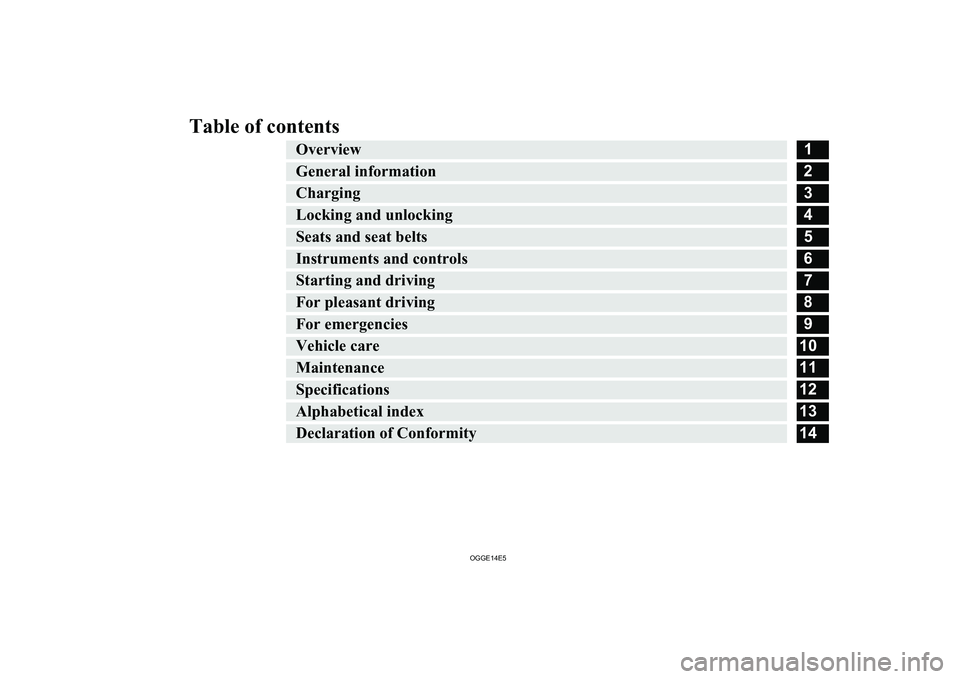
Table of contentsOverview1General information2Charging3Locking and unlocking4Seats and seat belts5Instruments and controls6Starting and driving7For pleasant driving8For emergencies9Vehicle care10Maintenance11Specifications12Alphabetical index13Declaration of Conformity14
OGGE14E5
Page 14 of 442
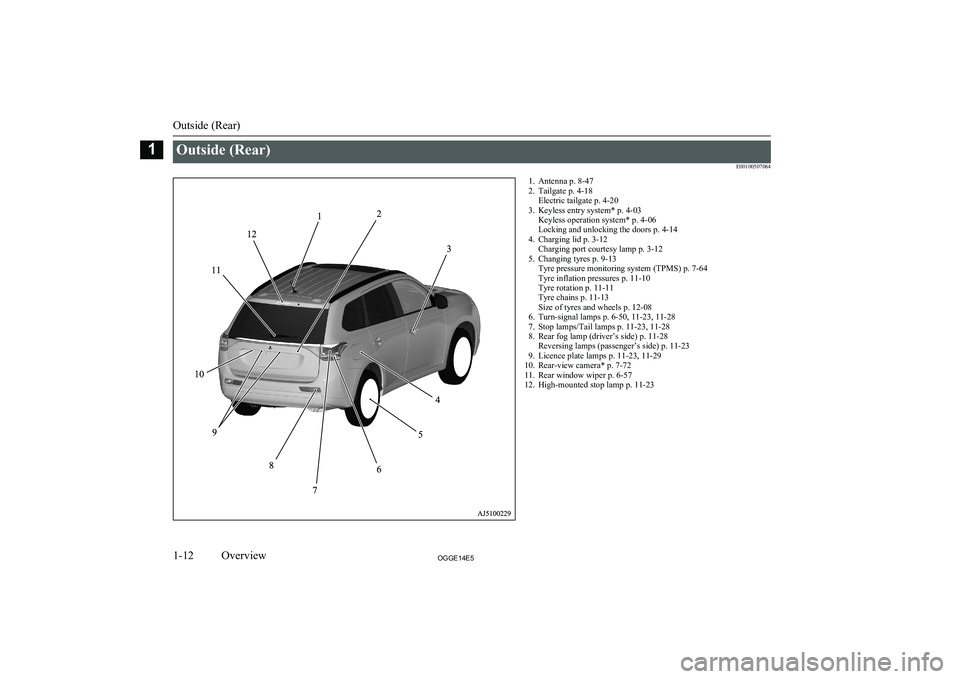
Outside (Rear)E001005070641. Antenna p. 8-472. Tailgate p. 4-18 Electric tailgate p. 4-20
3. Keyless entry system* p. 4-03 Keyless operation system* p. 4-06
Locking and unlocking the doors p. 4-14
4. Charging lid p. 3-12 Charging port courtesy lamp p. 3-12
5. Changing tyres p. 9-13 Tyre pressure monitoring system (TPMS) p. 7-64
Tyre inflation pressures p. 11-10
Tyre rotation p. 11-11
Tyre chains p. 11-13
Size of tyres and wheels p. 12-08
6. Turn-signal lamps p. 6-50, 11-23, 11-28
7. Stop lamps/Tail lamps p. 11-23, 11-28
8. Rear fog lamp (driver’s side) p. 11-28 Reversing lamps (passenger’s side) p. 11-23
9. Licence plate lamps p. 11-23, 11-29
10. Rear-view camera* p. 7-72
11. Rear window wiper p. 6-57
12. High-mounted stop lamp p. 11-23
Outside (Rear)
1-12OGGE14E5Overview1
Page 16 of 442
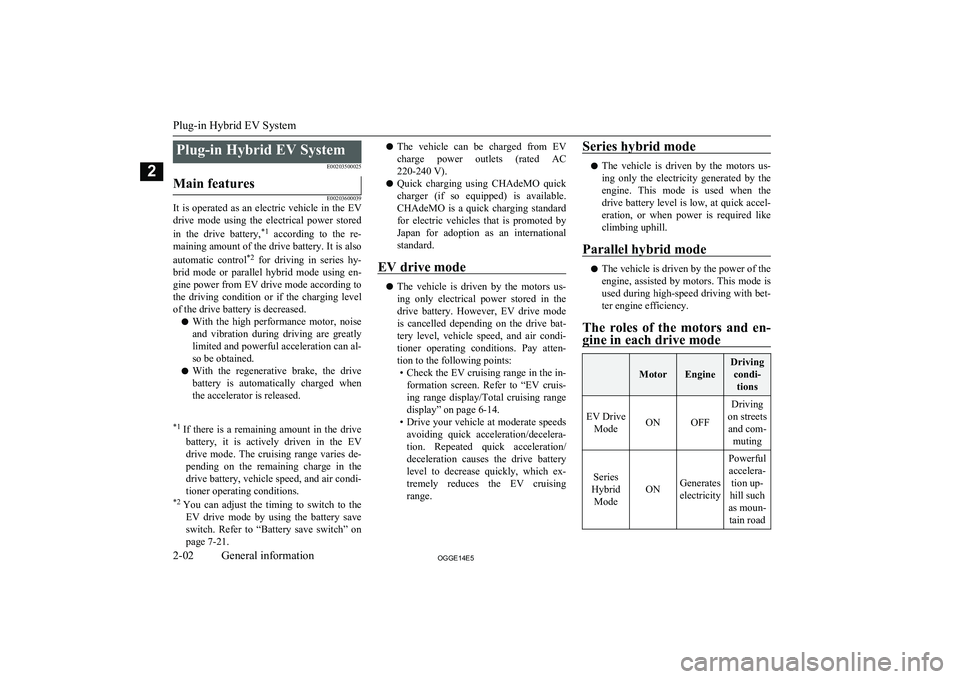
Plug-in Hybrid EV SystemE00203500025Main features
E00203600039
It is operated as an electric vehicle in the EVdrive mode using the electrical power stored
in the drive battery, *1
according to the re-
maining amount of the drive battery. It is also
automatic control *2
for driving in series hy-
brid mode or parallel hybrid mode using en-
gine power from EV drive mode according to the driving condition or if the charging level
of the drive battery is decreased.
l With the high performance motor, noise
and vibration during driving are greatlylimited and powerful acceleration can al-
so be obtained.
l With the regenerative brake, the drive
battery is automatically charged when
the accelerator is released.
*1 If there is a remaining amount in the drive
battery, it is actively driven in the EV
drive mode. The cruising range varies de-
pending on the remaining charge in the drive battery, vehicle speed, and air condi- tioner operating conditions.
*2 You can adjust the timing to switch to the
EV drive mode by using the battery save
switch. Refer to “Battery save switch” on
page 7-21.l The vehicle can be charged from EV
charge power outlets (rated AC 220-240 V).
l Quick charging using CHAdeMO quick
charger (if so equipped) is available.
CHAdeMO is a quick charging standard
for electric vehicles that is promoted by
Japan for adoption as an international
standard.
EV drive mode
l The vehicle is driven by the motors us-
ing only electrical power stored in the drive battery. However, EV drive mode is cancelled depending on the drive bat-
tery level, vehicle speed, and air condi-
tioner operating conditions. Pay atten- tion to the following points: • Check the EV cruising range in the in-
formation screen. Refer to “EV cruis-
ing range display/Total cruising range display” on page 6-14.
• Drive your vehicle at moderate speeds
avoiding quick acceleration/decelera- tion. Repeated quick acceleration/deceleration causes the drive battery
level to decrease quickly, which ex- tremely reduces the EV cruising
range.
Series hybrid mode
l The vehicle is driven by the motors us-
ing only the electricity generated by the
engine. This mode is used when the drive battery level is low, at quick accel-
eration, or when power is required like climbing uphill.
Parallel hybrid mode
l The vehicle is driven by the power of the
engine, assisted by motors. This mode is used during high-speed driving with bet-ter engine efficiency.
The roles of the motors and en-
gine in each drive mode
MotorEngine
Driving
condi- tions
EV Drive ModeONOFF
Driving
on streets and com- muting
Series
Hybrid Mode
ONGenerates
electricity
Powerful accelera- tion up-
hill such
as moun- tain road
Plug-in Hybrid EV System
2-02OGGE14E5General information2
Page 18 of 442
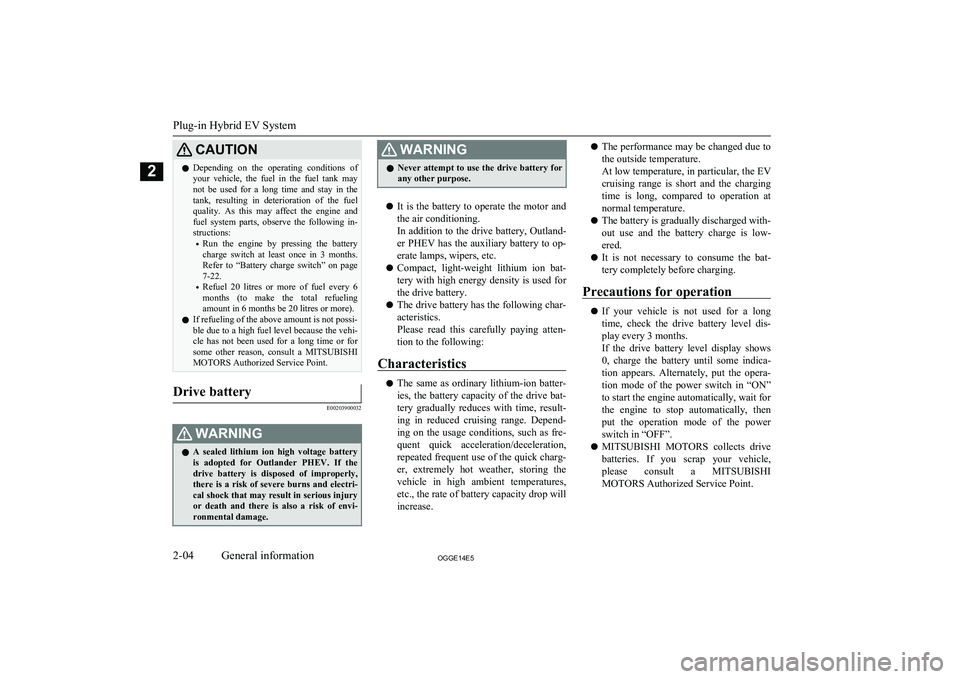
CAUTIONlDepending on the operating conditions of
your vehicle, the fuel in the fuel tank may
not be used for a long time and stay in the tank, resulting in deterioration of the fuel
quality. As this may affect the engine and fuel system parts, observe the following in-
structions:
• Run the engine by pressing the battery
charge switch at least once in 3 months.
Refer to “Battery charge switch” on page 7-22.
• Refuel 20 litres or more of fuel every 6
months (to make the total refueling amount in 6 months be 20 litres or more).
l If refueling of the above amount is not possi-
ble due to a high fuel level because the vehi-
cle has not been used for a long time or for
some other reason, consult a MITSUBISHI
MOTORS Authorized Service Point.Drive battery
E00203900032
WARNINGl A sealed lithium ion high voltage battery
is adopted for Outlander PHEV. If the
drive battery is disposed of improperly, there is a risk of severe burns and electri-
cal shock that may result in serious injury
or death and there is also a risk of envi- ronmental damage.WARNINGl Never attempt to use the drive battery for
any other purpose.
l It is the battery to operate the motor and
the air conditioning.
In addition to the drive battery, Outland-
er PHEV has the auxiliary battery to op-
erate lamps, wipers, etc.
l Compact, light-weight lithium ion bat-
tery with high energy density is used forthe drive battery.
l The drive battery has the following char-
acteristics.
Please read this carefully paying atten- tion to the following:
Characteristics
l The same as ordinary lithium-ion batter-
ies, the battery capacity of the drive bat-
tery gradually reduces with time, result- ing in reduced cruising range. Depend-
ing on the usage conditions, such as fre- quent quick acceleration/deceleration, repeated frequent use of the quick charg-
er, extremely hot weather, storing the vehicle in high ambient temperatures, etc., the rate of battery capacity drop willincrease.
l The performance may be changed due to
the outside temperature.
At low temperature, in particular, the EV cruising range is short and the charging
time is long, compared to operation at normal temperature.
l The battery is gradually discharged with-
out use and the battery charge is low- ered.
l It is not necessary to consume the bat-
tery completely before charging.
Precautions for operation
l If your vehicle is not used for a long
time, check the drive battery level dis- play every 3 months.
If the drive battery level display shows
0, charge the battery until some indica-
tion appears. Alternately, put the opera- tion mode of the power switch in “ON”to start the engine automatically, wait for
the engine to stop automatically, then
put the operation mode of the power
switch in “OFF”.
l MITSUBISHI
MOTORS collects drive
batteries. If you scrap your vehicle,
please consult a MITSUBISHI
MOTORS Authorized Service Point.
Plug-in Hybrid EV System
2-04OGGE14E5General information2
Page 19 of 442
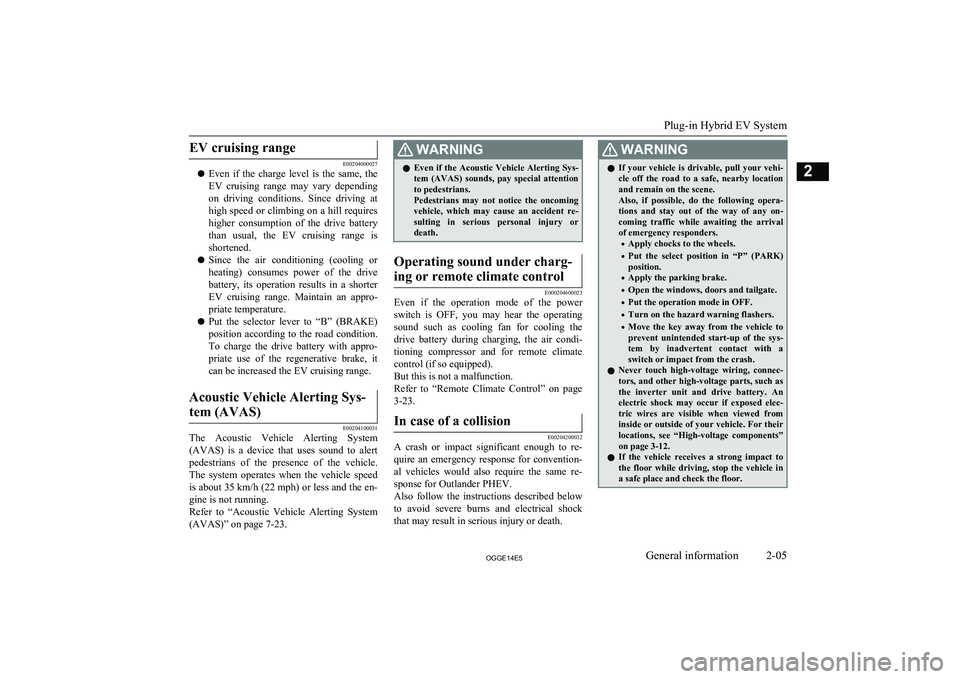
EV cruising range
E00204000027
l Even if the charge level is the same, the
EV cruising range may vary depending
on driving conditions. Since driving at high speed or climbing on a hill requireshigher consumption of the drive batterythan usual, the EV cruising range is
shortened.
l Since the air conditioning (cooling or
heating) consumes power of the drive battery, its operation results in a shorterEV cruising range. Maintain an appro-
priate temperature.
l Put the selector lever to “B” (BRAKE)
position according to the road condition. To charge the drive battery with appro-priate use of the regenerative brake, it can be increased the EV cruising range.
Acoustic Vehicle Alerting Sys-
tem (AVAS)
E00204100031
The Acoustic Vehicle Alerting System
(AVAS) is a device that uses sound to alert pedestrians of the presence of the vehicle.The system operates when the vehicle speed
is about 35 km/h (22 mph) or less and the en-
gine is not running.
Refer to “Acoustic Vehicle Alerting System
(AVAS)” on page 7-23.
WARNINGl Even if the Acoustic Vehicle Alerting Sys-
tem (AVAS) sounds, pay special attention
to pedestrians.
Pedestrians may not notice the oncoming vehicle, which may cause an accident re-
sulting in serious personal injury or death.Operating sound under charg-
ing or remote climate control
E000204600023
Even if the operation mode of the power
switch is OFF, you may hear the operating
sound such as cooling fan for cooling the
drive battery during charging, the air condi- tioning compressor and for remote climate control (if so equipped).
But this is not a malfunction.
Refer to “Remote Climate Control” on page
3-23.
In case of a collision
E00204200032
A crash or impact significant enough to re-
quire an emergency response for convention- al vehicles would also require the same re-sponse for Outlander PHEV.
Also follow the instructions described below to avoid severe burns and electrical shock
that may result in serious injury or death.
WARNINGl If your vehicle is drivable, pull your vehi-
cle off the road to a safe, nearby location and remain on the scene.
Also, if possible, do the following opera- tions and stay out of the way of any on-
coming traffic while awaiting the arrival of emergency responders.
• Apply chocks to the wheels.
• Put the select position in “P” (PARK)
position.
• Apply the parking brake.
• Open the windows, doors and tailgate.
• Put the operation mode in OFF.
• Turn on the hazard warning flashers.
• Move the key away from the vehicle to
prevent unintended start-up of the sys- tem by inadvertent contact with a switch or impact from the crash.
l Never touch high-voltage wiring, connec-
tors, and other high-voltage parts, such as the inverter unit and drive battery. Anelectric shock may occur if exposed elec-
tric wires are visible when viewed from inside or outside of your vehicle. For their locations, see “High-voltage components”
on page 3-12.
l If the vehicle receives a strong impact to
the floor while driving, stop the vehicle in
a safe place and check the floor.
Plug-in Hybrid EV System
2-05OGGE14E5General information2
Page 21 of 442
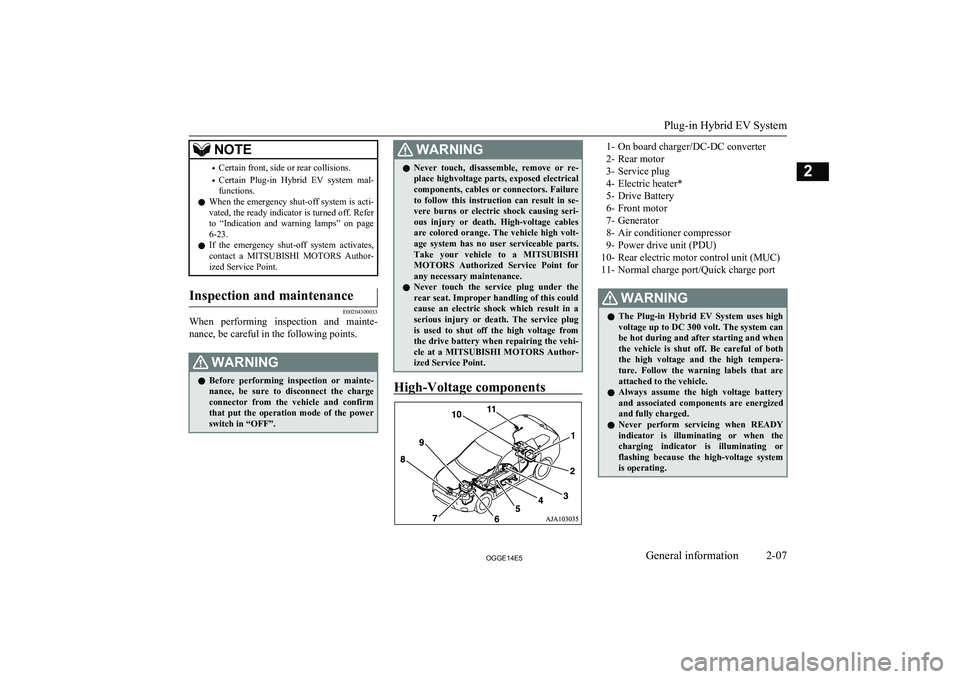
NOTE•Certain front, side or rear collisions.
• Certain Plug-in Hybrid EV system mal-
functions.
l When the emergency shut-off system is acti-
vated, the ready indicator is turned off. Refer
to “Indication and warning lamps” on page 6-23.
l If the emergency shut-off system activates,
contact a MITSUBISHI MOTORS Author-
ized Service Point.Inspection and maintenance
E00204300033
When performing inspection and mainte-
nance, be careful in the following points.
WARNINGl Before performing inspection or mainte-
nance, be sure to disconnect the charge connector from the vehicle and confirmthat put the operation mode of the power
switch in “OFF”.WARNINGl Never touch, disassemble, remove or re-
place highvoltage parts, exposed electrical
components, cables or connectors. Failure
to follow this instruction can result in se- vere burns or electric shock causing seri-ous injury or death. High-voltage cables are colored orange. The vehicle high volt-
age system has no user serviceable parts. Take your vehicle to a MITSUBISHI
MOTORS Authorized Service Point for
any necessary maintenance.
l Never touch the service plug under the
rear seat. Improper handling of this could
cause an electric shock which result in a
serious injury or death. The service plug
is used to shut off the high voltage from the drive battery when repairing the vehi-
cle at a MITSUBISHI MOTORS Author-
ized Service Point.
High-Voltage components
1- On board charger/DC-DC converter
2- Rear motor
3- Service plug
4- Electric heater*
5- Drive Battery
6- Front motor
7- Generator
8- Air conditioner compressor
9- Power drive unit (PDU)
10- Rear electric motor control unit (MUC) 11- Normal charge port/Quick charge portWARNINGl The Plug-in Hybrid EV System uses high
voltage up to DC 300 volt. The system can
be hot during and after starting and when the vehicle is shut off. Be careful of both the high voltage and the high tempera-
ture. Follow the warning labels that are
attached to the vehicle.
l Always assume the high voltage battery
and associated components are energized and fully charged.
l Never perform servicing when READY
indicator is illuminating or when the charging indicator is illuminating orflashing because the high-voltage system
is operating.
Plug-in Hybrid EV System
2-07OGGE14E5General information2
Page 22 of 442
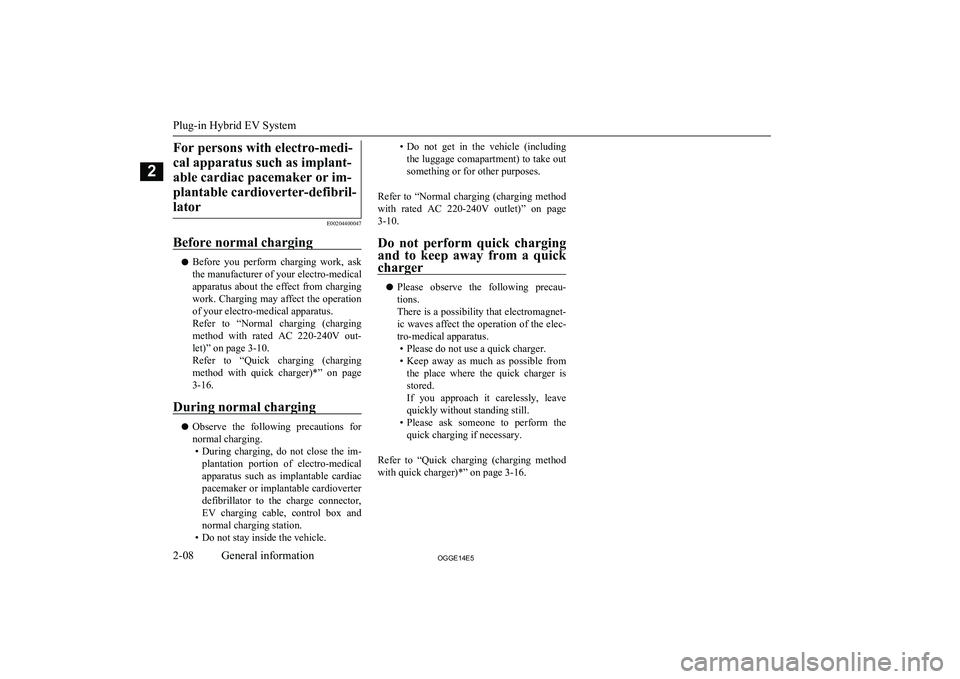
For persons with electro-medi-cal apparatus such as implant- able cardiac pacemaker or im-plantable cardioverter-defibril-lator
E00204400047
Before normal charging
l Before you perform charging work, ask
the manufacturer of your electro-medical
apparatus about the effect from charging work. Charging may affect the operation
of your electro-medical apparatus.
Refer to “Normal charging (charging
method with rated AC 220-240V out-
let)” on page 3-10.
Refer to “Quick charging (charging
method with quick charger)*” on page
3-16.
During normal charging
l Observe the following precautions for
normal charging. • During charging, do not close the im-
plantation portion of electro-medical apparatus such as implantable cardiac
pacemaker or implantable cardioverter defibrillator to the charge connector,
EV charging cable, control box and normal charging station.
• Do not stay inside the vehicle.
• Do not get in the vehicle (including
the luggage comapartment) to take out
something or for other purposes.
Refer to “Normal charging (charging method with rated AC 220-240V outlet)” on page 3-10.
Do not perform quick charging
and to keep away from a quick charger
l Please observe the following precau-
tions.
There is a possibility that electromagnet-
ic waves affect the operation of the elec- tro-medical apparatus. • Please do not use a quick charger.
• Keep away as much as possible from
the place where the quick charger is
stored.
If you approach it carelessly, leave quickly without standing still.
• Please ask someone to perform the
quick charging if necessary.
Refer to “Quick charging (charging method
with quick charger)*” on page 3-16.
Plug-in Hybrid EV System
2-08OGGE14E5General information2
Page 23 of 442
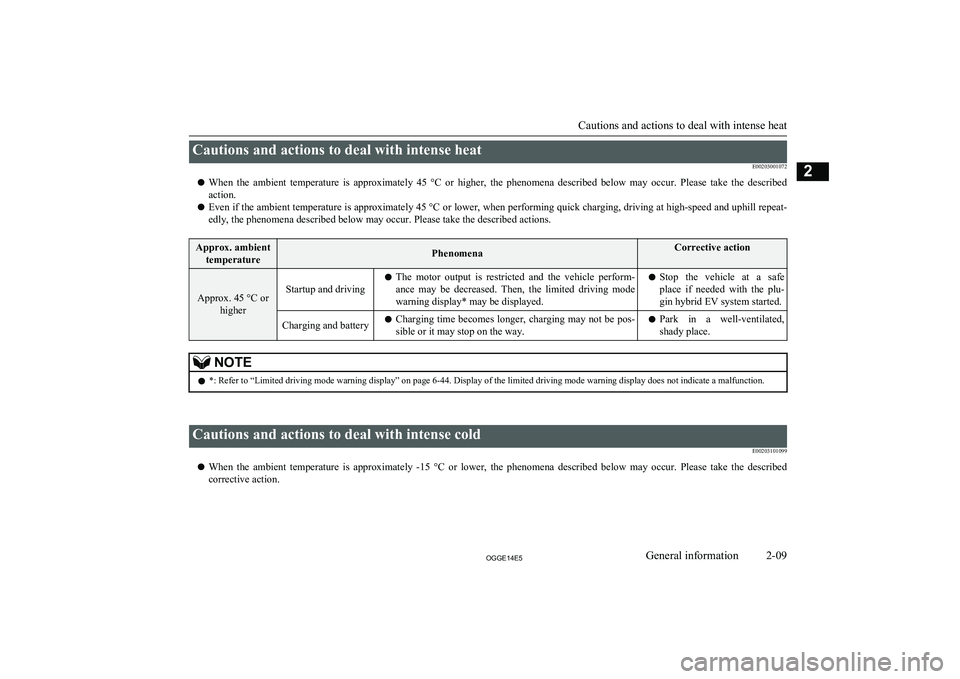
Cautions and actions to deal with intense heatE00203001072
l When the ambient temperature is approximately 45 °C or higher, the phenomena described below may occur. Please take the described
action.
l Even if the ambient temperature is approximately
45 °C or lower, when performing quick charging, driving at high-speed and uphill repeat-
edly, the phenomena described below may occur. Please take the described actions.Approx. ambient temperaturePhenomenaCorrective action
Approx. 45 °C or higherStartup and drivinglThe motor output is restricted and the vehicle perform-
ance may be decreased. Then, the limited driving mode
warning display* may be displayed.l Stop the vehicle at a safe
place if needed with the plu- gin hybrid EV system started.Charging and batteryl Charging time becomes longer, charging may not be pos-
sible or it may stop on the way.l Park in a well-ventilated,
shady place.NOTEl *: Refer to “Limited driving mode warning display” on page 6-44. Display of the limited driving mode warning display does not indicate a malfunction.
Cautions and actions to deal with intense cold
E00203101099
l When the ambient temperature is approximately -15 °C or lower, the phenomena described below may occur. Please take the described
corrective action.
Cautions and actions to deal with intense heat
2-09OGGE14E5General information2
Page 24 of 442
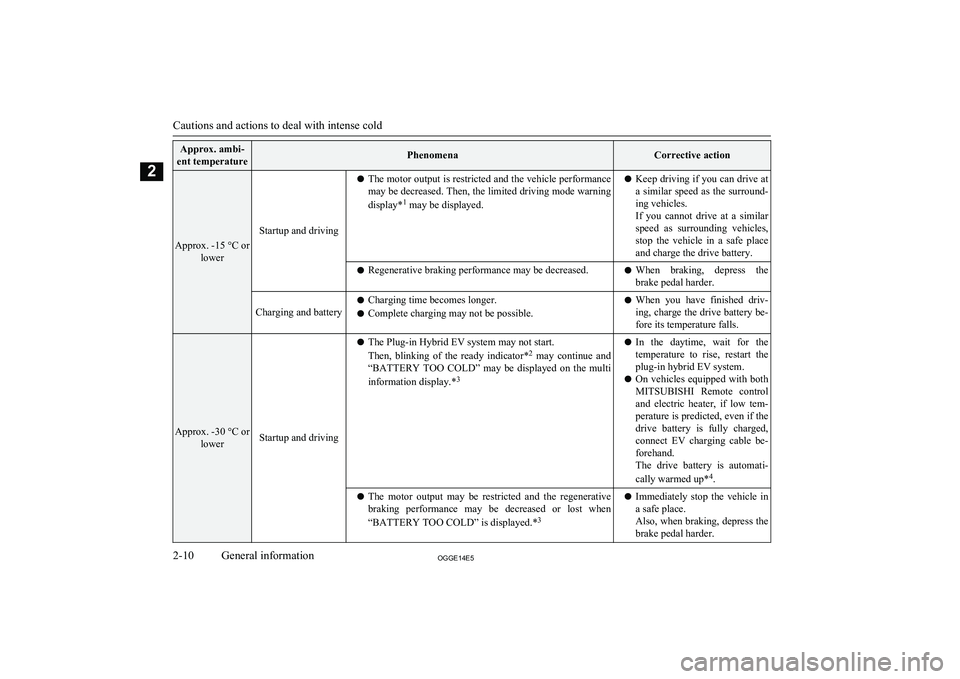
Approx. ambi-
ent temperaturePhenomenaCorrective action
Approx. -15 °C or lower
Startup and driving
lThe motor output is restricted and the vehicle performance
may be decreased. Then, the limited driving mode warning
display* 1
may be displayed.l Keep driving if you can drive at
a similar speed as the surround-
ing vehicles.
If you cannot drive at a similar
speed as surrounding vehicles,
stop the vehicle in a safe place and charge the drive battery.l Regenerative braking performance may be decreased.l When braking, depress the
brake pedal harder.Charging and batteryl Charging time becomes longer.
l Complete charging may not be possible.l When you have finished driv-
ing, charge the drive battery be-
fore its temperature falls.
Approx. -30 °C or lowerStartup and driving
lThe Plug-in Hybrid EV system may not start.
Then, blinking of the ready indicator* 2
may continue and
“BATTERY TOO COLD” may be displayed on the multi
information display.* 3l
In the daytime, wait for the
temperature to rise, restart the
plug-in hybrid EV system.
l On vehicles equipped with both
MITSUBISHI Remote control
and electric heater, if low tem-
perature is predicted, even if the drive battery is fully charged, connect EV charging cable be-
forehand.
The drive battery is automati-
cally warmed up* 4
.l The motor output may be restricted and the regenerative
braking performance may be decreased or lost when
“BATTERY TOO COLD” is displayed.* 3l
Immediately stop the vehicle in
a safe place.
Also, when braking, depress the brake pedal harder.
Cautions and actions to deal with intense cold
2-10OGGE14E5General information2
Page 25 of 442
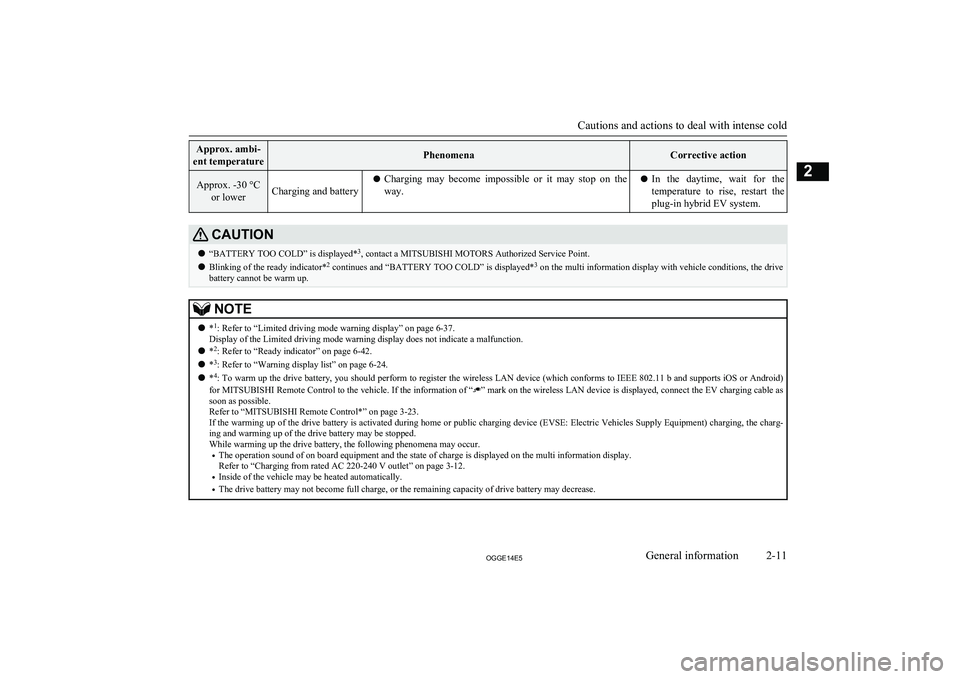
Approx. ambi-
ent temperaturePhenomenaCorrective actionApprox. -30 °C or lowerCharging and batterylCharging may become impossible or it may stop on the
way.l In the daytime, wait for the
temperature to rise, restart theplug-in hybrid EV system.CAUTIONl “BATTERY TOO COLD” is displayed* 3
, contact a MITSUBISHI MOTORS Authorized Service Point.
l Blinking of the ready indicator* 2
continues and “BATTERY TOO COLD” is displayed* 3
on the multi information display with vehicle conditions, the drive
battery cannot be warm up.NOTEl *1
: Refer to “Limited driving mode warning display” on page 6-37.
Display of the Limited driving mode warning display does not indicate a malfunction.
l *2
: Refer to “Ready indicator” on page 6-42.
l *3
: Refer to “Warning display list” on page 6-24.
l *4
: To warm up the drive battery, you should perform to register the wireless LAN device (which conforms to IEEE 802.11 b and supports iOS or Android)
for MITSUBISHI Remote Control to the vehicle. If the information of “
” mark on the wireless LAN device is displayed, connect the EV charging cable as
soon as possible.
Refer to “MITSUBISHI Remote Control*” on page 3-23.
If the warming up of the drive battery is activated during home or public charging device (EVSE: Electric Vehicles Supply Equipment) charging, the charg-
ing and warming up of the drive battery may be stopped.
While warming up the drive battery, the following phenomena may occur.
• The operation sound of on board equipment and the state of charge is displayed on the multi information display.
Refer to “Charging from rated AC 220-240 V outlet” on page 3-12.
• Inside of the vehicle may be heated automatically.
• The drive battery may not become full charge, or the remaining capacity of drive battery may decrease.
Cautions and actions to deal with intense cold
2-11OGGE14E5General information2